Do Hospital Parking Lots Have Cameras
On a frigid nighttime in January 2019, Carlie Beaudin finished up with her cancer patients at Froedtert Hospital before long before one a.m. The 33-year-old nurse practitioner pulled on her wintertime coat, wrapped her red scarf around her neck and headed to her car.
She rode the elevator downward to Level Ii in the underground parking garage. As she made her fashion to her Toyota Rav4, a man stepped out from behind a concrete pillar. Beaudin stopped briefly every bit he said something to her; then she kept walking.

When she got to her motorcar, the human — a stranger who had in one case been a valet at the infirmary — ran up and tackled her. He kicked her and stomped on her caput and body more than than 40 times. Then he pulled her into her auto and drove to the snowy rooftop of a parking garage next door, where he dumped her out and drove over her. Somewhere forth the way, he also choked her.
The attack carried on for six minutes, captured by surveillance cameras. In fact, cameras had recorded the man earlier the set on, lurking around the hospital and hiding behind pillars for two and a half hours.
Just Froedtert's security squad had failed to act.
Beaudin lay in the cold, unnoticed by anybody at Froedtert for virtually three hours, until a snowplow commuter spotted her wedged under her auto, her body frozen to the ground. She was taken to the emergency room, where she was declared dead.
The COVID-19 pandemic has rallied extraordinary support for wellness workers: Billboards, yard signs and TV commercials have honored their sacrifice. Simply the less obvious risk to their well-being — violence at work — has persisted long before the pandemic and has been repeatedly disregarded by hospital administrators, regulators and lawmakers, an investigation by the Milwaukee Periodical Sentinel has found.
The nation's v.2 one thousand thousand infirmary workers are especially vulnerable, non just inside caring for the sick and injured but as they come and get to work. Made upwards of near lxxx% women, their shifts brainstorm and end at all hours of the nighttime, and their employers often require them to park in faraway lots and poorly lit garages.
Even as health care companies accept taken in billions in revenue, with some recording tape profits, hospitals across the country have frequently allowed parking garages to get unstaffed, cameras unmonitored and nurses to fend for themselves, documents and interviews testify.
"I would literally look left and look correct and then run to my car," said Tierney Flynn, a nurse who worked at Columbia St. Mary'southward on Milwaukee'due south east side from 2017 until February.
In Omaha, Nebraska, 3 months before Beaudin was browbeaten to death, a nurse in her early 20s was assaulted by a stranger with a gun in a infirmary parking lot. Like the assail at Froedtert, surveillance video showed the perpetrator was able to linger effectually the hospital undeterred past security. Earlier the attack, nurses had repeatedly complained to supervisors well-nigh condom in the area.
And three months after Beaudin was killed, a nurse in Dallas was robbed at gunpoint in a hospital parking lot. Like her counterparts in Omaha, she had complained weeks earlier most the lack of security in the lot.
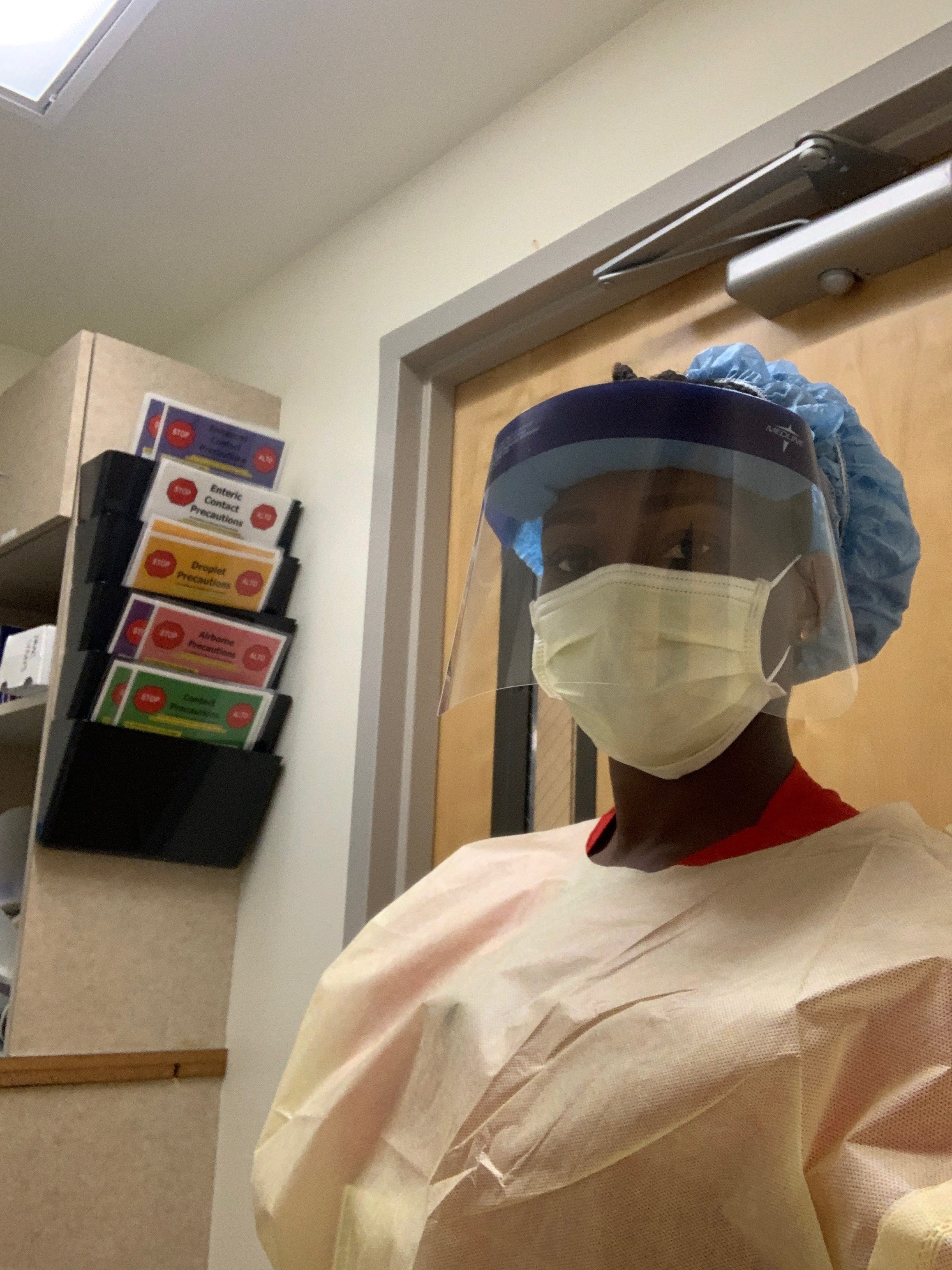
Mawata Kamara has been a registered nurse since 2008 and spent 5 years traveling among hospitals across the country.
"They don't say anything in nursing school that prepares us for the violence," said Kamara, who at present works in the San Francisco Bay area.
To assess the safety of hospital parking garages in the Milwaukee area, the Journal Sentinel hired a Florida-based security and criminal offence prevention proficient to examine eight structures. His spot cheque — over ii days in May 2019 — found bones condom and security shortcomings at every ane of them.
At Ascension Columbia St. Mary's Hospital on Milwaukee's eastward side, lighting levels in some spots were 30 times lower than industry standards.
A Periodical Sentinel reporter as well conducted 1-hour checks of the parking garages in February to run across if they had guards at entrance booths and how frequently security officers patrolled at night. At Aurora St. Luke's, no security came through during the check. Downtown at Mount Sinai Hospital, 57 minutes passed before a patrol drove by.
Representatives from Froedtert and the other hospitals tested by the Periodical Lookout said they take multiple layers of security and that the safety of patients, visitors and employees is their top priority. None would concur to interviews or answer questions most specific policies.
"Froedtert Hospital continues to develop an surroundings of rubber that applies beyond departments and touches on all of our interactions with staff, patients, and visitors," spokesman Stephen Schooff wrote in an email to the Periodical Picket.
In November, Froedtert reached an out-of-courtroom settlement with Beaudin's husband, Nick, for an undisclosed amount.
Many state and local lawmakers and regulators take not addressed the hazards, failing to pass legislation requiring workplace violence prevention programs and neglecting to enforce lighting codes. Code enforcement officers from Milwaukee, Waukesha and Wauwatosa, where Froedtert is located, said they could not recall ever citing a parking garage owner for bereft lighting.
The U.S. Occupational Prophylactic and Wellness Administration, which is charged with protecting the nation'southward workforce, has done little to enforce the requirement that hospitals, like all employers, provide safety workplaces. The agency's guidelines for parking-area condom are voluntary, and the agency issued just eighteen citations from 1991 to 2014 to health care employers for declining to address violence on their campuses.
Nobody can say exactly how many have been killed and harmed in hospital parking garages. No federal agency tracks these numbers; information from local police force enforcement are often incomplete and imprecise, and many hospitals themselves don't compile the figures.
In California, the but state to rail and publish detailed information on hospital violence, health care workers were victims of 218 "violent incidents" in their parking areas from July 2017 to Dec 2019, according to the state's OSHA unit.
Hospitals in nigh states are not required to release information about violence on their properties. Every bit a result, it's difficult for the public and workers to agree hospitals accountable for the violence.
And nurses and other health care workers — who now make up America'due south largest workforce — continue to be victimized.
"Some of the most exposed people in the world are nurses getting off on the midnight shift," said David Salmon, a security expert with Texas-based OSS Law Enforcement Advisors, who specializes in parking condom. "You talk about vulnerability."
"Predators love to prey on hospitals," Salmon said.
'Please, I am begging of you lot'
Mary Ball felt it in her gut when she pulled into the Parkland Hospital parking lot in northward Dallas. Something wasn't right. Information technology was about 6:35 p.m, and the sun was depression in the April sky.
The three young men standing on the nearby sidewalk seemed like they were looking at her strangely. As she parked her Honda Accord, she paused for a trounce. Her shift started in 10 minutes. She had about a third-of-a-mile walk to the hospital. She had to hustle.
She gathered her bag, stepped out of her automobile and locked the door. When she turned around, the 3 men were directly in front end of her. The human being in the middle reached into the front pocket of his hoodie and pulled out a gun.
Pointing it at her chest, he demanded her wallet, car keys and Apple watch. As she handed them over, two of the men got into her car. The third stood with the gun pointed at her. Then he, as well, got into her automobile.
Dallas nurse robbed at gunpoint in hospital parking lot
After parking her car, nurse Mary Ball was robbed past iii men at gunpoint on her manner into piece of work at Parkland Hospital in Dallas in April 2019.
Mike De Sisti, Milwaukee Journal Sentinel
"I stood there in complete disbelief," she said. "So I realized they however had a gun and could shoot me, and so I turned around and ran as fast as I could, toward the hospital."
Ball's machine was found afterwards that evening smashed into a pole in southward Dallas. Police caught 2 of the men merely not the third.
What is especially noteworthy about the carjacking last twelvemonth is what happened less than an hour afterward.
While sitting in the hospital'southward police station, Ball emailed senior executives of Parkland Hospital. "I'm with police now but I'k so upset with Parkland's continuous lack of security for staff when this is a very high risk area and I have brought this upward in the past," Brawl wrote in the email, a copy of which was shared with the Journal Sentinel. "Please, I am begging of yous, what volition it take to brand employee safety something of significance?"
Ball had emailed nursing supervisors several months earlier the carjacking wondering why there seemed to be fewer security guards effectually the parking areas. The 38-twelvemonth-old said in an interview with the Periodical Lookout man that she was told that the hospital's law department was short-staffed and that they had been shifting more officers to the emergency department.
As she filed her police report, officers informed her that the cameras in the hospital'due south parking lot were not working at the time she was robbed. Brawl had known the gate to the employee parking lot had been broken for weeks, opening for everyone who pulled upwardly; now she was learning the cameras were not functioning.
"I was livid," Brawl said.
Afterwards that nighttime, Ball received an e-mail response from Judy Herrington, the hospital'due south vice president of medicine services: "I am so very distressing this horrible outcome happened to yous. Delight know nosotros will support you lot in whatsoever way nosotros can in getting through this emotionally."
The adjacent day, Herrington emailed Ball once more, saying Parkland was working on safety improvements and that the cleaved camera arrangement was the fault of a structure crew.
"This was a heck of a way to realize what a blind spot it left," Herrington wrote.
The following 24-hour interval, when Ball went to the infirmary to run across with police, she noticed the parking lot gate was nevertheless broken.
"Sadly I could just drive in, no badge access required still," she wrote to Herrington. "I'chiliad so lamentable to see get-go hand that my attack has not changed precautions to keep the staff who nevertheless work there safe."
When Ball returned a few days later, repairs still had non been made, she said.
She once more emailed Herrington. "Trinity lot is still open to the public and non restricted access. It's a real shame," she wrote. "Employees across Parkland take reached out to me to tell me how unsafe they have felt and how they have brought this upwardly and information technology's never addressed."
On Apr fifteen, a calendar week after the robbery, Herrington emailed Ball, informing her that the hospital expected to resolve many of her concerns within a week or so. Herrington said the construction crew was also responsible for the broken gate.
Herrington and other Parkland Hospital representatives declined interview requests from the Journal Scout.
Records obtained past the Journal Scout show that in the twelvemonth before Ball'southward carjacking, hospital police responded to 12 violent assaults and robberies on the Parkland campus, including a rape.
According to Ball, in the weeks following her carjacking, Parkland added security car patrols to the parking lots, repaired the cameras and gate, and gave employees noise alarms to add together to their badges.
Simply the added security measures did non resolve all of Brawl'south concerns. She said the alarms are loud simply don't connect to the security operations eye; aught prevents the general public from walking through the Parkland parking lot someday, and the escort service remains slow. Ball said she does non know whatsoever employee who uses it.
She said that every mean solar day, she dreads going in and leaving work. "That walk is awful," she said.
Her fears are not unfounded. Records show that in November, 7 months afterwards Brawl'southward carjacking, four men pulled a knife on a 29-yr-quondam adult female at another Parkland Hospital parking surface area.
A double danger
Parking garages, in general, are inherently dangerous places. And so are hospitals. Put the two together, and you have a potentially deadly mix.
Parking garages — whether at hospitals, hotels or downtown offices — are the tertiary virtually mutual place for assaults, abductions and homicides after private homes and streets, alleys or sidewalks, according to FBI data from 2018, the most recent yr for which numbers are available.
More homicides happen in parking garages than at bars, motels, gas stations or in the woods combined, the numbers testify.
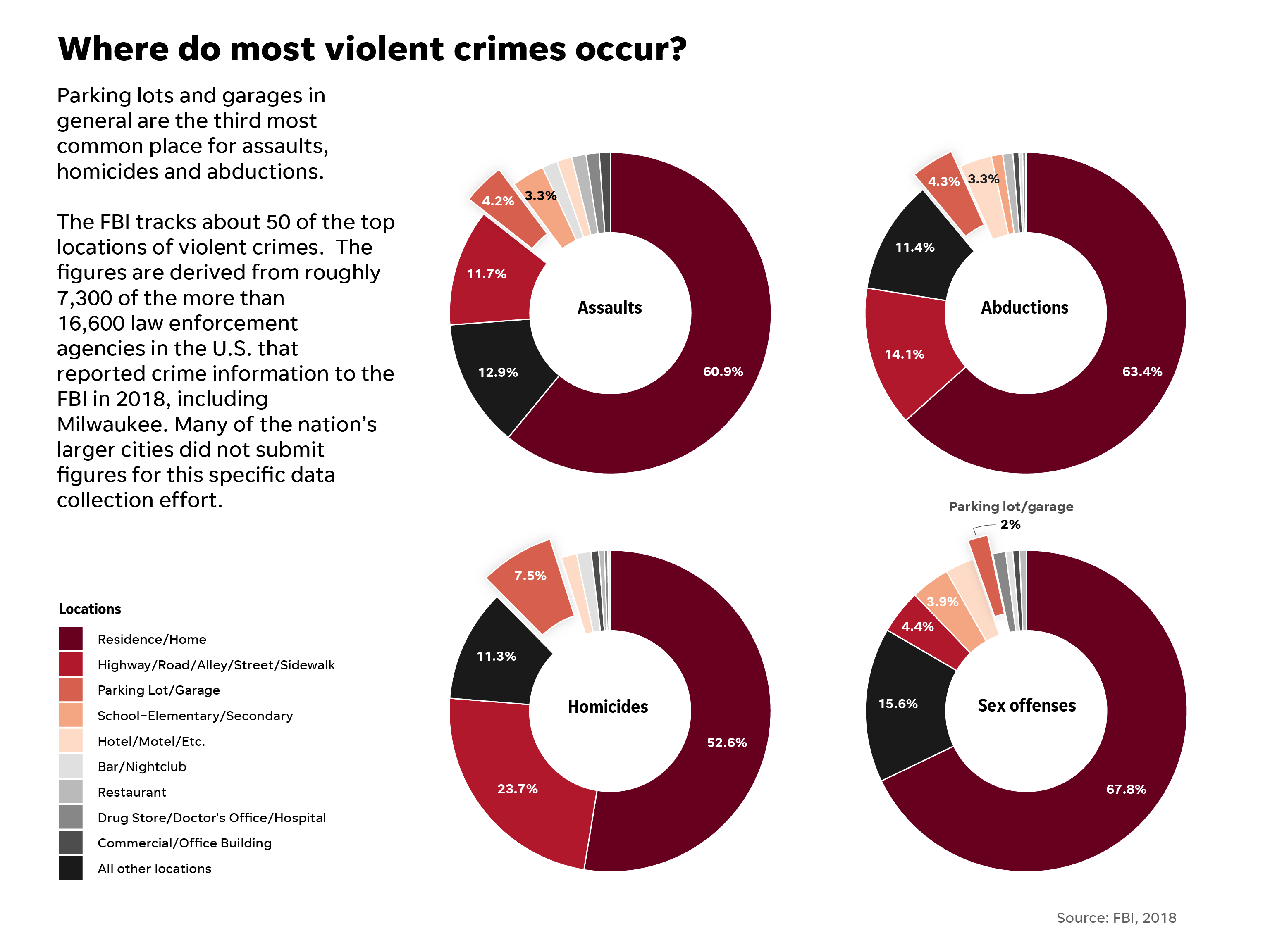
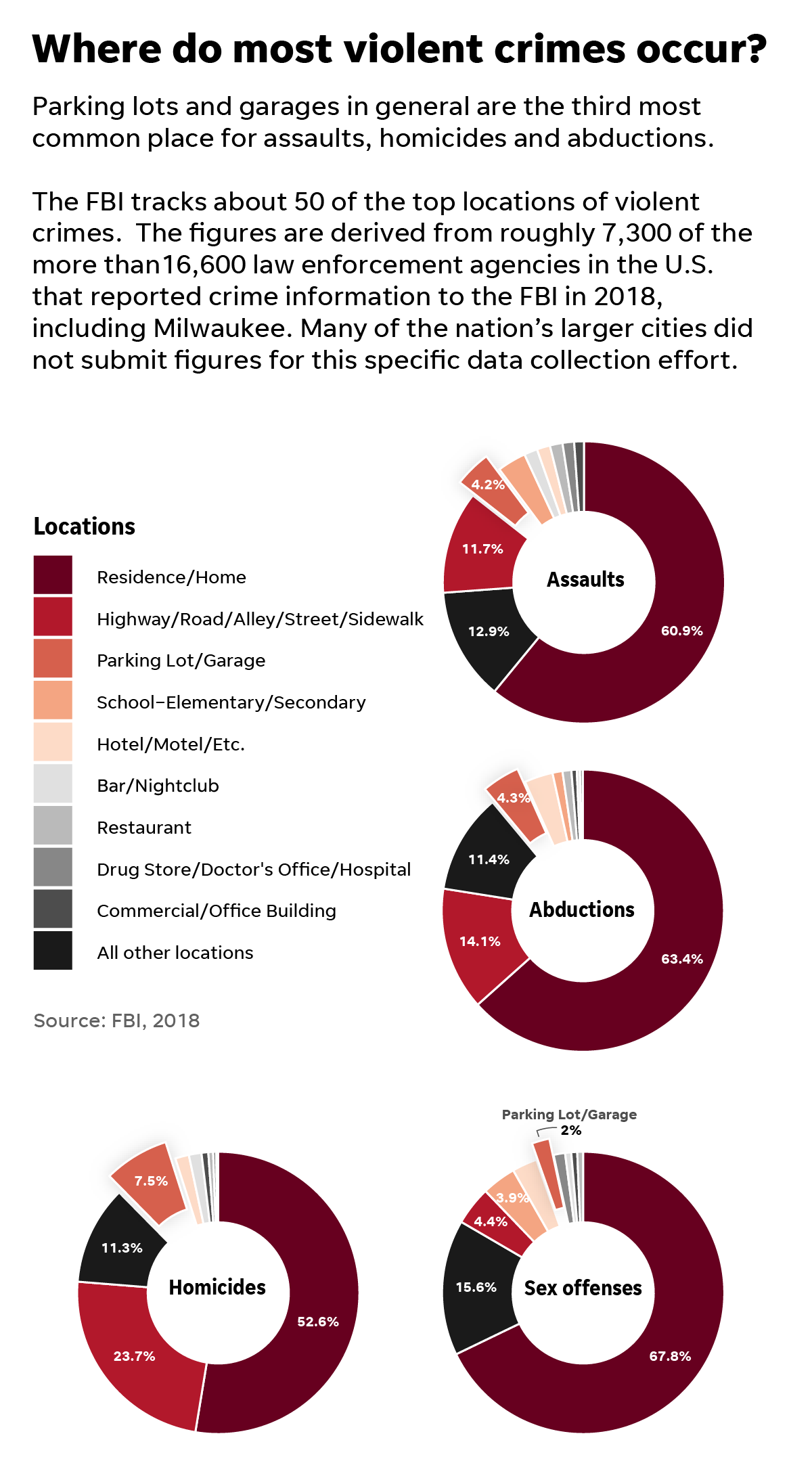
"You have an indefensible position if y'all try to say, 'We didn't call up it could happen hither,'" said Alan Butler, former president of the International Clan for Healthcare Security & Safety, the leading trade association for health care security professionals.
Crime numbers involving health care workers are every bit striking: In parking areas and elsewhere on the job, the country's 16 million wellness care employees are at least iv times more likely on average than other professionals to be victims of workplace violence, data bear witness.
While they help heal wounds and ease patients' pain, they are kicked, punched, scratched, spit on, high-strung and otherwise assaulted at rates that far exceed any other individual sector industry, co-ordinate to information from the U.South. Bureau of Labor Statistics.
They are injured past violence at rates that roughly equal — and in some cases surpass — those of constabulary officers and security guards, a Journal Sentinel analysis of the labor figures shows.
And violence confronting health care workers is escalating, academic and industry studies show. The violent crime rate on hospital properties jumped 55% from 2015 to 2018, according to a survey past the international health intendance security group. Roughly nine of 10 victims were employees.
While attacks on nurses and other hospital workers more unremarkably take place in emergency departments, psychiatric wards and patients' rooms, some of the more serious violence — armed robberies, abductions and rapes — oft occurs in the parking and exterior areas, studies bear witness.
In California, for case, knives were wielded in less than one% of all violent incidents, yet they were used in ten% of the cases reported in parking lots, an analysis by the Journal Spotter plant.
Hospital administrators have known nigh the risks in parking areas for decades.
A 1991 survey by the international wellness care security group establish that nearly 70% of armed robberies and 56% of rapes of health care workers occurred in parking and next areas. "Clearly, parking security represents a major challenge for hospitals, demanding time, personnel, equipment and dollars," authors of the report wrote.
In the 1970s, numerous nurse abductions and slayings fabricated national headlines.
"I felt lucky to exist live," said Randi Olson, a nurse who in 1976 was grabbed at knifepoint from a Chicago hospital parking lot, raped and thrown in the trunk of her car. "Usually, they kill you."
Ii years after Olson'south assail — in an eerily similar case — a man pulled a gun on Linda Goldstone, a 29-year-quondam mom on her style to work at Northwestern Memorial Hospital in Chicago where she taught a Lamaze form. The man shoved her into his car, raped her and and so forced her into the trunk. He held her captive for ii days before killing her.
"It's a longstanding problem, and it's getting worse," said Michelle Mahon, a nurse and spokeswoman for National Nurses United, which represents more than 150,000 registered nurses in the country. "Our unabridged club is under stress, and the infirmary is often the place where these stresses converge."
Tests show light below standards
Level Two of Froedtert'southward Parking Garage five looked fairly well-lit on a well-baked night in May 2019, about four months afterward Carlie Beaudin was browbeaten to decease.
Randy Atlas walked around the murder site holding a gadget that looked like an electrical razor. But it was a light meter, measuring lighting in "pes-candles."
A pes-candle is the corporeality of light equivalent to what a candle would illuminate in a i-square-foot area. The lighting level inside virtually big-box stores, for example, measures about 30 foot-candles. Film theaters register about 0.v to 1.
Lighting is universally considered among the well-nigh important security features in parking garages. Yet state and municipal codes vary widely. Some crave just 1 foot-candle, which is an industry standard aimed simply at ensuring motorists can navigate the surface area.

Taking condom into account, the International Association for Healthcare Security & Safety, with more than than 2,000 members worldwide, recommends parking garages take at to the lowest degree six pes-candles of calorie-free. Some municipalities, such as Milwaukee and Wauwatosa, accept more stringent requirements, mandating new garages be constructed with a minimum of 10 foot-candles.
Older buildings are required to meet codes that were in identify at the time of construction; however, when information technology comes to enforcement, language in Milwaukee'due south ordinance is vague, requiring the structures simply take "sufficient" lighting.
Equally Atlas fabricated his style through several hospital garages in the Milwaukee area, all failed to meet industry standards or mod-24-hour interval municipal codes, co-ordinate to his measurements.
The Periodical Sentinel hired Atlas, a nationally recognized expert on building security, for two days to assess eight parking garages at five Milwaukee-expanse hospitals: Aurora Sinai, Rising Columbia St. Mary's, Rising St. Joseph'southward, Froedtert Memorial Lutheran Hospital and Aurora St. Luke'south Medical Middle.
Accompanied by a reporter and photographer from the Periodical Watch, Atlas assessed lighting in each garage and other safety factors. He looked for surveillance cameras, noted whether a parking attendant or a security patrol was on-site, checked for corner mirrors and emergency call boxes, and gauged access points and stairwell visibility.
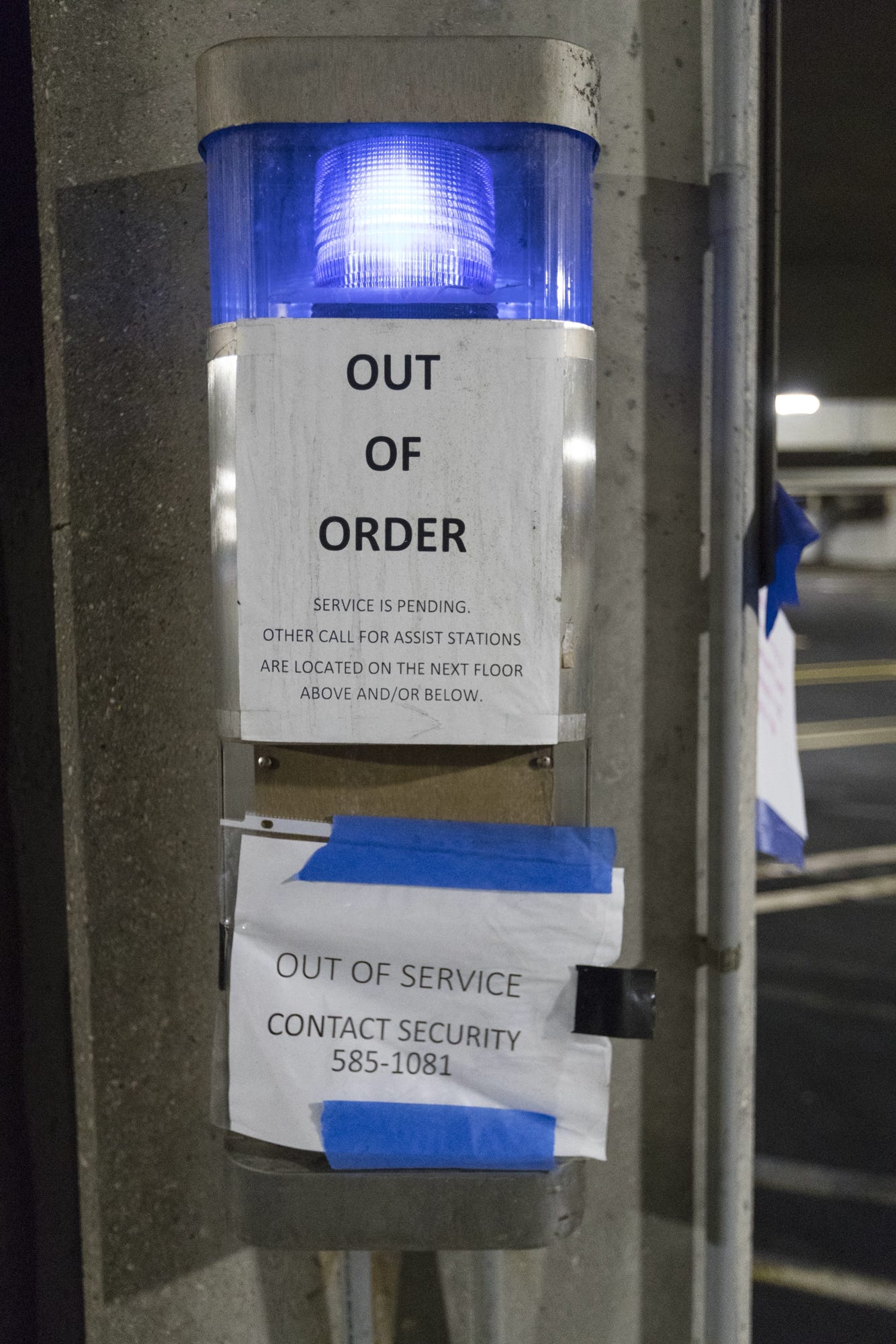
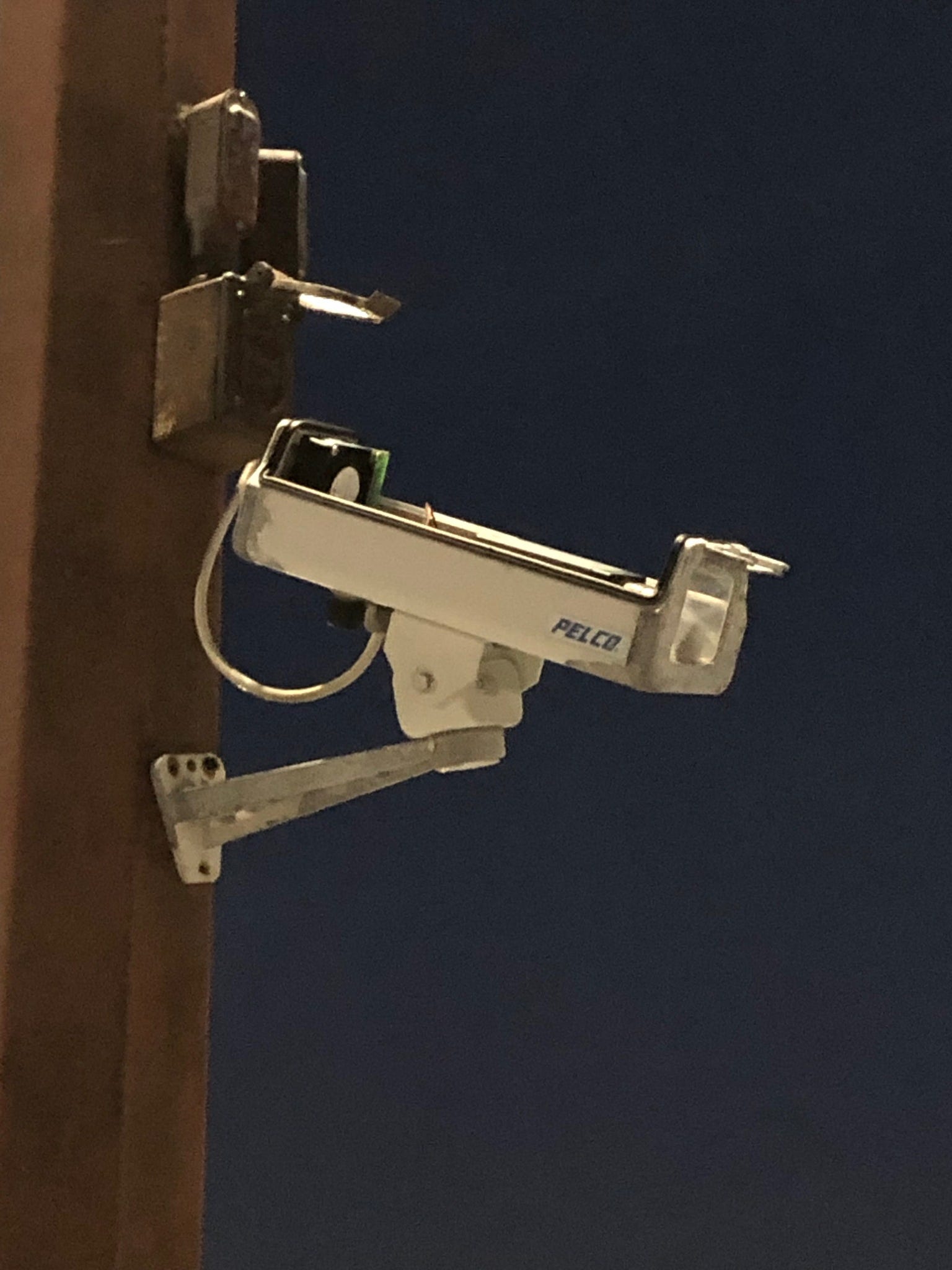

Though not meant to serve as a regulatory check or to rank the hospital garages, the assessment nonetheless offered clues as to where hospitals might exist falling short.
On this May nighttime, Level Two of Froedtert'south Garage 5 where Beaudin was attacked initially looked fine, Atlas said. Video surveillance was well-placed, and Atlas noticed motion-activated light sensors and blue calorie-free emergency call boxes. A roving security vehicle passed through while he was walking around.
But Atlas found an important design flaw with the garage: wide concrete columns providing plenty of hiding spots for people with ill intent.
And when Atlas held the low-cal meter in the aisles where the cars were parked, the lighting measured between 4 and 6.5 foot-candles — well short of Wauwatosa's requirement of 10.
Simply neither Wauwatosa nor the City of Milwaukee inspects parking garages for compliance with lighting, other than for emergency and go out lights, which fall nether burn down codes, officials with both cities said.
Inspectors typically visit when they receive complaints, said Mike Mannan, manager of edifice code enforcement for commercial properties for the Urban center of Milwaukee. And usually, the complaints are from neighbors of buildings with too much lighting, Mannan said.
"Nosotros don't accept the staffing to become through every parking garage to see if in that location's acceptable lighting," he said.
It's unclear what the conditions were the night Beaudin was killed. Froedtert won't say what specific improvements, if any, to the two parking garages were fabricated following her death.
Atlas' spot check plant problems at the other garages. Two of Columbia St. Mary'due south garages on Milwaukee's due east side, including where a woman was stabbed by a stranger more than a dozen times in 2018, had inconsistent and shadowy lighting.
"We're looking for even distribution," Atlas said. "Not brightness back to darkness. Your eyes tin can't adjust, and you can be easily ambushed."
One of the garages, built in the mid-1970s, registered just 0.2 foot-candles in some spots near the cars, far below the industry standard of vi and Milwaukee's mod-solar day standard of 10.
"If we're looking at a garage with two-tenths of a human foot-candle, that's about one-half the lite of a full moon," Atlas said. "It'southward dark."
Representatives from Columbia St. Mary's would not reply questions from the Journal Sentinel, responding only with a statement via email.
"Our campuses have a combination of 24/7 cameras and garage patrol services, emergency call systems, security escort services and enhanced LED lighting," a spokeswoman wrote. "Nosotros review and strengthen our safety operations regularly as part of our commitment to the wellbeing of the communities we are privileged to serve."
Atlas' overall cess of Milwaukee'southward hospital garages: boilerplate in terms of security-focused ecology design but troubling in terms of lighting.
"At that place were areas that were very nighttime, and some of the readings we institute proved that," he said.
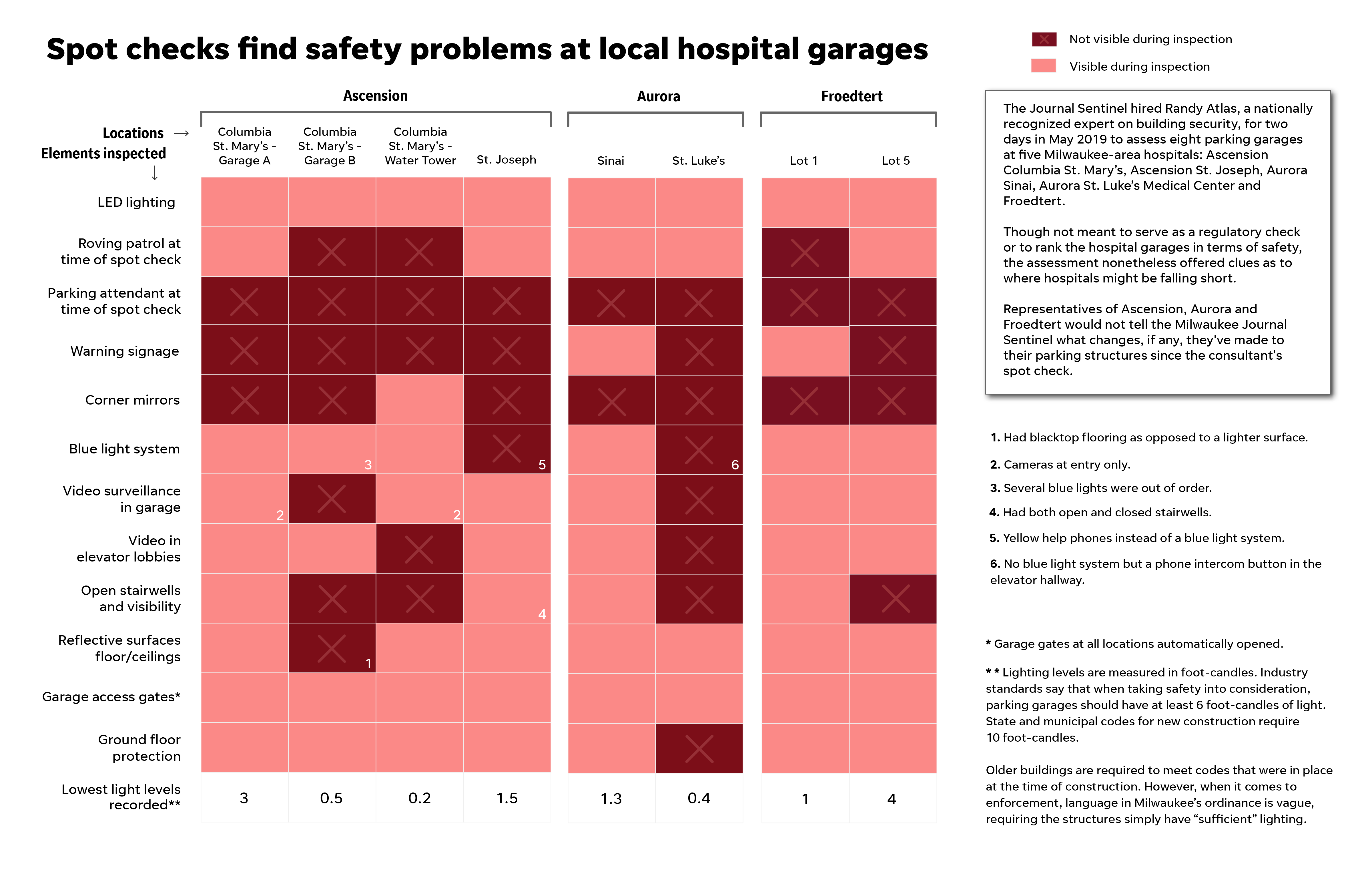
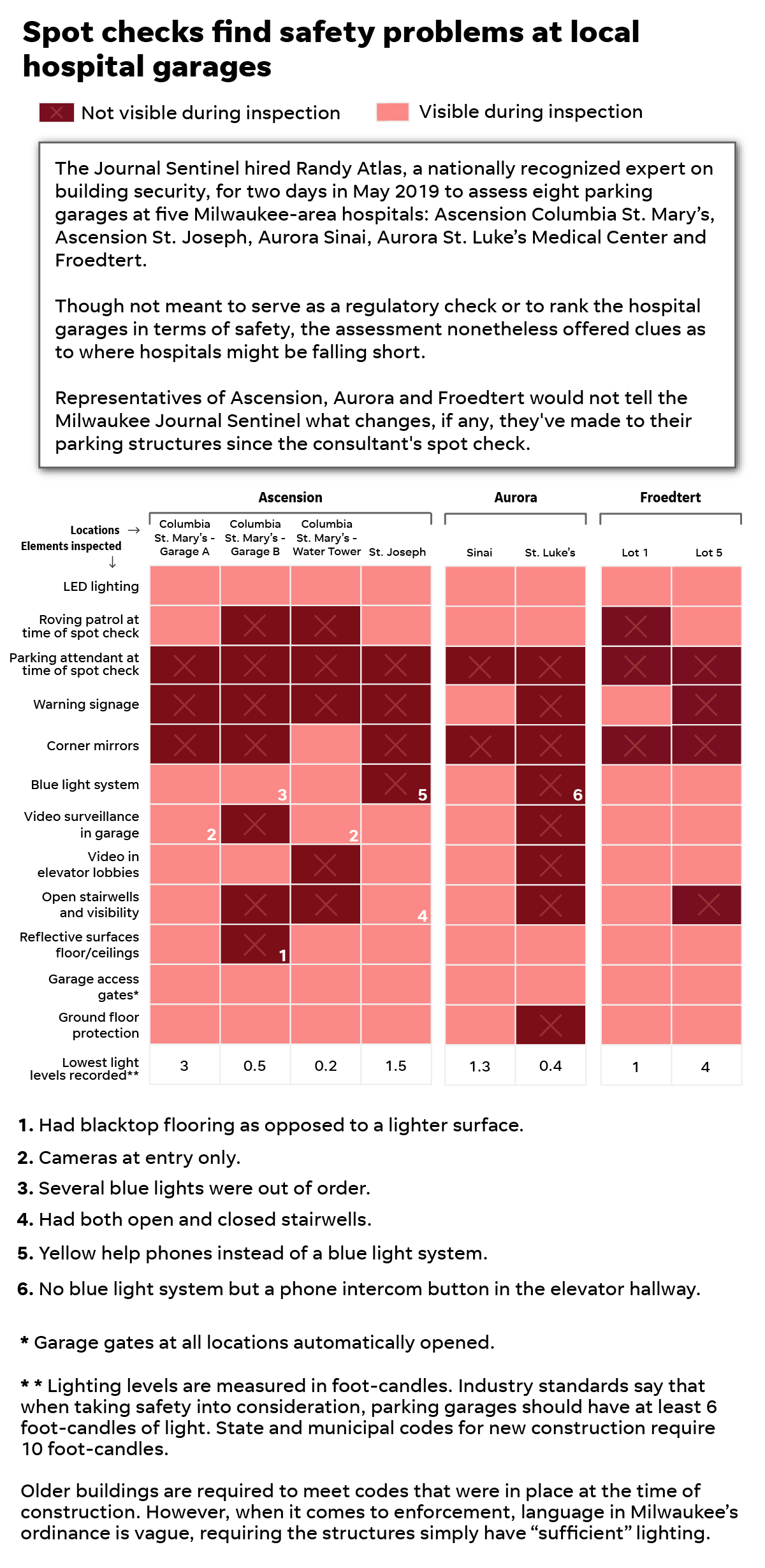
'You take your chances'
In the wake of a serious criminal offence in a parking garage, hospitals typically fix broken lights, install more cameras, add roving patrols, offer to escort workers to their cars and send emails reminding staff to walk in groups or pairs.
But the added safeguards are often insufficient and temporary, the Journal Sentinel investigation found.
For example, nurses from across the country repeatedly said in interviews their hospitals' escort programs are dull and impractical. The last affair anybody wants to exercise later working a long shift is await another half-hour to get to their cars, they said.
"Y'all're tired. You're ready to become," said Yvette Harris, a registered nurse from Riverside, California. "You accept your chances, and you pretty much pray."
Ii nurses at Creighton Bergan Mercy Hospital in Omaha said that well earlier their co-worker was assaulted at gunpoint in 2018 they had complained repeatedly to supervisors about having to walk solitary — often late at night past a jitney stop where drug users commonly hung out — to become to their designated parking area.
"This is a daily effect for nurses: Am I going to get mugged in the parking lot?" said one of the nurses, who did not want her name published out of fearfulness of retribution by the hospital. Another nurse at the same hospital said security remains sparse more than than a year subsequently their co-worker's set on. "Not sure where [the security guards] are half the fourth dimension and non a heck of a lot of low-cal in some areas," she said in a written message to the Periodical Lookout man.
Creighton Bergan Mercy Hospital representatives did not respond to telephone calls and emails from the Journal Picket.
Video shows assailant lingering in foyer
Amir Muhammad lingered in the lobby of Omaha's Creighton Bergan Mercy Hospital before following a nurse to her car in 2018. He put a gun to her head and attacked her.
Creighton Bergan Mercy Hospital
Despite mounting force per unit area from nurses and others in the manufacture, fewer than a dozen states have adopted legislation requiring health care employers to develop policies aimed at preventing workplace violence. Wisconsin is not among them.
In California, nurses ramped upward force per unit area on state legislators in 2010 after a patient hit a nurse in the head with a lamp, killing her. New laws now crave wellness intendance employers to track violent incidents, identify risk factors, develop violence prevention plans and railroad train workers.
"This was a campus that had three security guards on the whole campus," said Renee Altaffer, a trauma nurse in the intensive care unit at Sutter Health in Roseville, California. "We had almost cypher in place to prevent something from happening."
The hospital added more a dozen security guards, fixed phone call boxes, upgraded cameras and implemented a company-check-in system, Altaffer said. "We recall everybody should be doing this."
In Philadelphia, nurses at hospitals in the Jefferson Health-Northeast chain were so afraid of the garages that they were parking on the street, said Michelle Conley, the chief nursing officer for the concatenation.
Conley said she and the hospital'southward security manager held listening sessions with staff and got an earful. "Nosotros took a beating," Conley said. "I hadn't understood the magnitude."
Equally a result, the hospital invested about $1 million on improvements, including upgrading lighting and calculation cameras, panic buttons and golf game carts to escort employees to their cars, she said.
After decades of inaction by Congress, the U.Due south. House of Representatives in November passed a nib that would require OSHA to mandate all hospitals and wellness intendance employers to implement workplace violence prevention programs.
The nib is in the Senate, but information technology's opposed past the American Hospital Association, a lobbying system with a membership of about 5,000 hospitals and health care facilities. The association argues its members already have adequate safety programs in place.
Although it's unclear how many hospitals really take formal workplace violence prevention programs, data from the infirmary association show that every bit of 2018 about half did non.
Ofttimes there isn't much incentive, said Butler, of the international health care security trade group. "Security as a whole does not generate revenue for an organization," he said.
OSHA has long recognized the danger health intendance workers face up. In 1996, the agency issued guidelines to help employers create workplace violence prevention programs, including in parking areas. Withal the guidelines take remained voluntary.
From 1991 to 2015, OSHA inspected an average of just 14 hospitals and health care facilities per year for workplace violence issues, co-ordinate to the U.South. Government Accountability Office, the investigative arm of Congress.
In Oregon, ane of the few states that has adopted workplace violence prevention laws, the state OSHA section issued just 8 fines over the final decade for violations related to workplace violence in health intendance institutions.
In one Oregon case reviewed by the Journal Picket, employees at a psychiatric hospital were assaulted virtually 300 times in a seven-calendar month period in 2017. The state OSHA department found the hospital was not properly logging and investigating all the assaults.
The agency fined the hospital $1,650 — or $5.50 per assault.
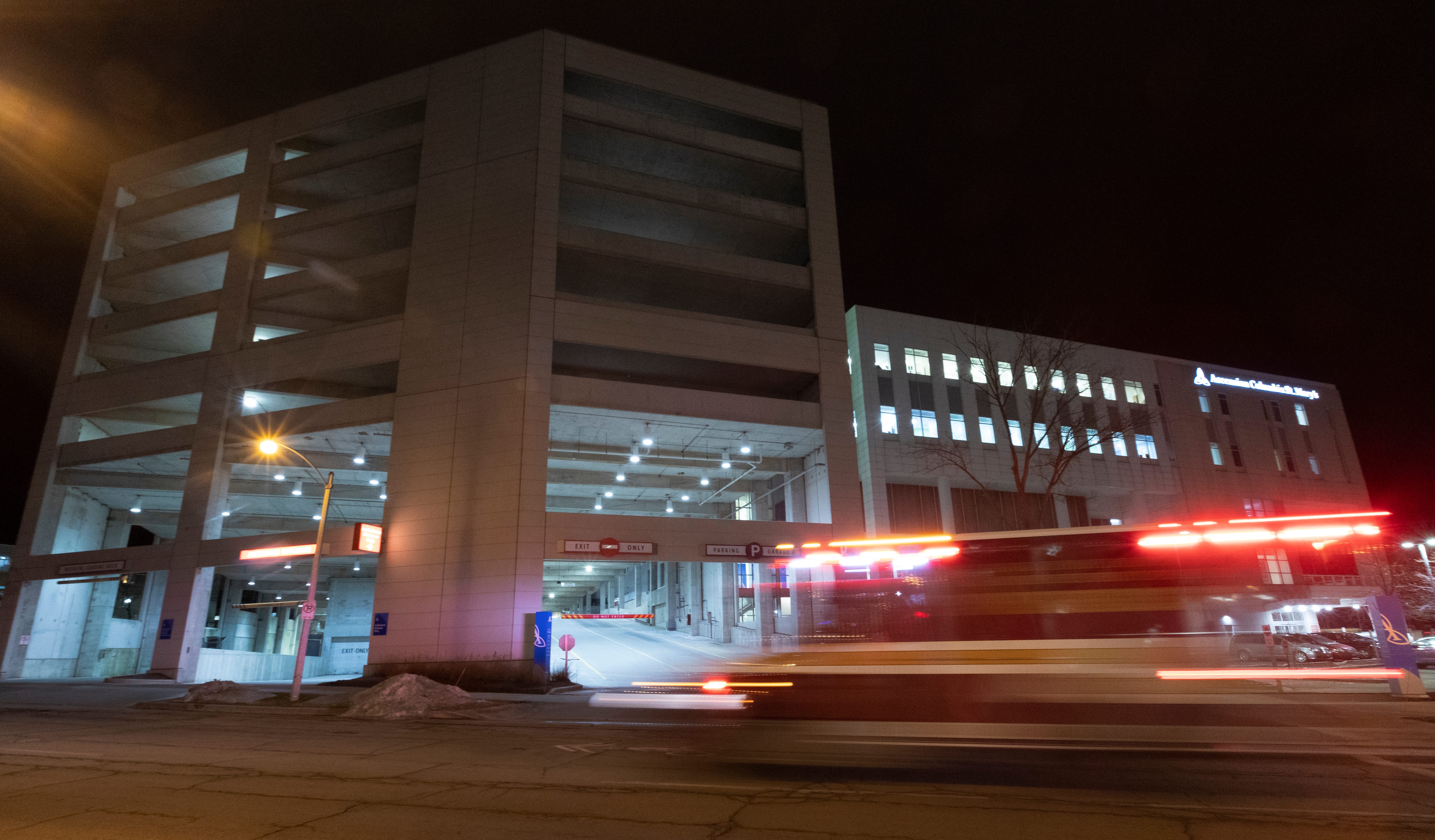
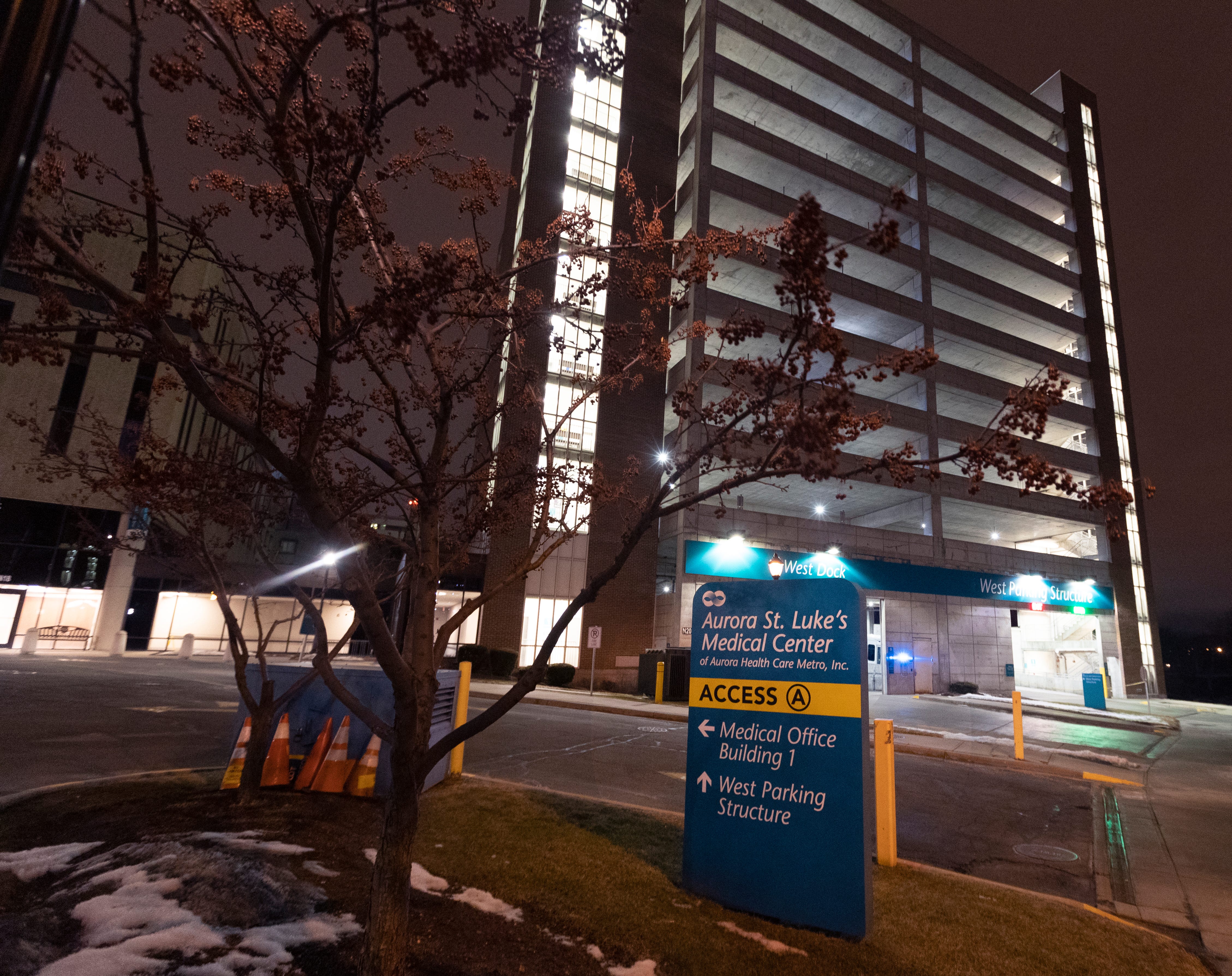
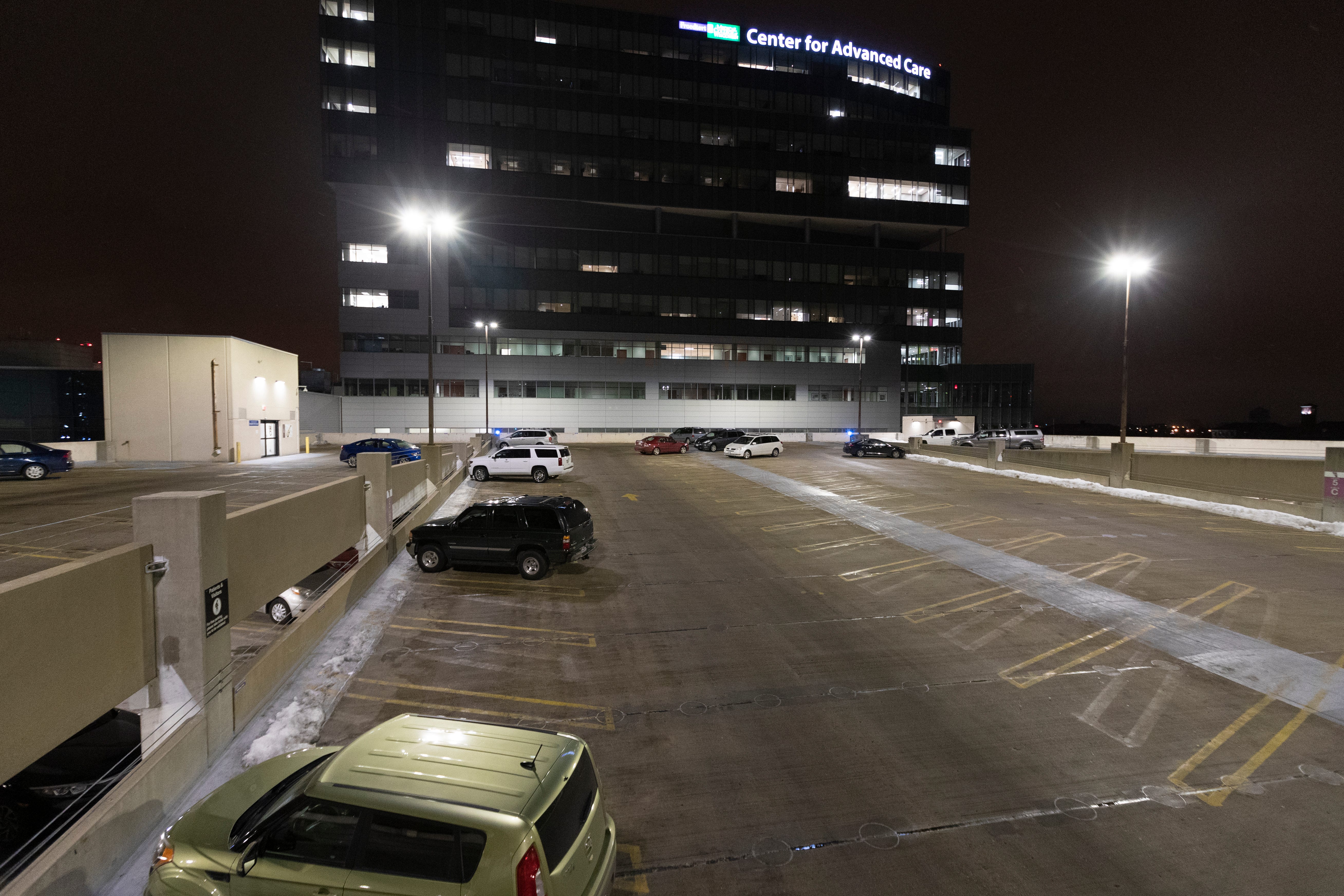
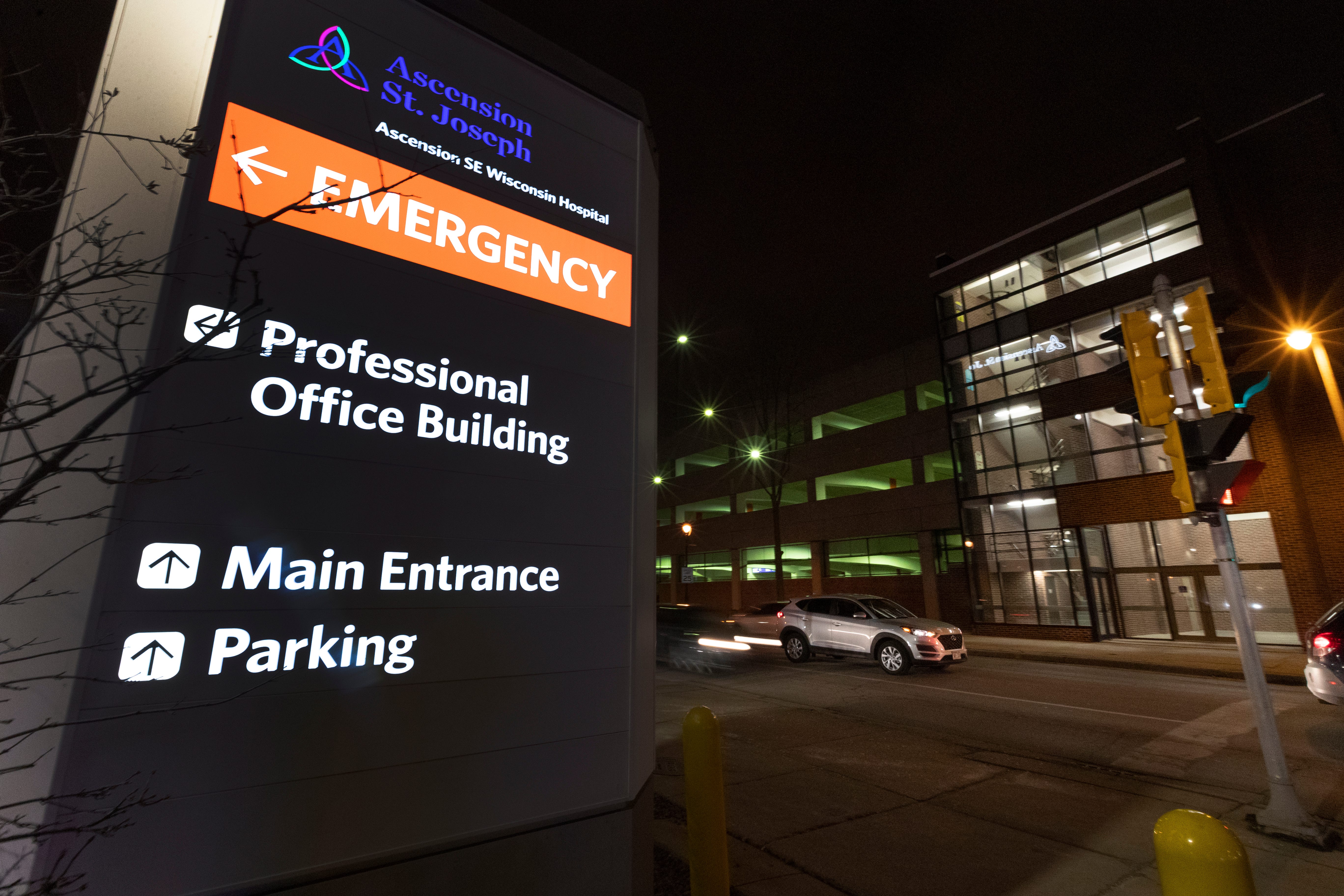
Unanswered questions
In the case of Carlie Beaudin, the nurse practitioner found murdered and frozen to the parking garage pavement, the amount was $0.
OSHA did not cite Froedtert Hospital or the Medical Higher of Wisconsin, which technically employed her.
The agency provided limited records to the Periodical Sentinel, withholding or blacking out many portions of the investigative file. In the documents OSHA did supply, investigators didn't address cardinal issues of the murder that were raised by other government.
For example, the Milwaukee County medical examiner's written report says the human being accused in Beaudin'due south homicide was "lurking around diverse places" on the hospital grounds for two and a half hours before the assault, including more than than an hour in the parking garage.
OSHA'south records make no mention of that or ways Froedtert might accept intercepted him.
The district attorney states in the criminal complaint against the man that the snowplow driver who first found Beaudin beneath her automobile sought aid via an emergency intercom system nearly the parking garage elevator but got no response.
OSHA'due south records say the emergency alerting/alarm systems were functional at the time of the murder. The documents practise not state why nobody responded when the snowplow driver called for help on the intercom.
Although OSHA inspectors reported that some of the hospital's 700 cameras across its campus are not monitored in existent-time, inspectors failed to address how that might place workers at take a chance. The photographic camera that recorded the six minutes during which Beaudin was beaten to death was not existence monitored at the fourth dimension, according to the OSHA records.
The inspectors noted that later the slaying, Froedtert stationed a security officeholder at each of the parking garages and lots. "It is unknown at this time if this exercise volition be maintained in place permanently," an inspector wrote.
Froedtert would not tell the Journal Sentinel whether the practise remains in place.
Federal OSHA investigators said the hospital and the college had comprehensive written workplace violence programs.
OSHA officials would non answer questions from the Journal Sentinel about the investigation.
Married man gets tattoo his married woman wanted
Nick Beaudin discusses the tattoo his wife wanted for herself before she was slain at a Froedtert Hospital parking garage.
Mike De Sisti, Milwaukee Journal Sentinel
Victor Harding, an chaser representing Carlie Beaudin's married man, Nick, called her death preventable. He said some of the surveillance cameras are "essentially scarecrows" and that a more sophisticated video arrangement could accept helped.
Security experts say software exists that can observe odd motions, such as when a person is bobbing up and down while peering in motorcar windows, and then alarm security. Froedtert would not comment on whether improvements take been fabricated to the hospital's video surveillance organization since Beaudin'south expiry.
The attorney as well said that the attacker was not required to sign in to the hospital when he arrived. Security experts agree that controlling access to infirmary grounds is disquisitional. They recommend that hospitals, like some public schools, crave visitors to sign in and wear a badge with their picture.
"If people take sick-intent, and they realize that their photo ID is going to be taken, that will give them a second thought," said Bryan Warren, a wellness care security consultant who has washed work for Froedtert unrelated to Beaudin's death.
Following Beaudin's decease, Froedtert began requiring visitors to bank check in and go passes during the overnight hours, according to Schooff, the hospital spokesman.
Kenneth Freeman, the homo charged in Beaudin'south death, was constitute guilty in February of committing the homicide and at the same time non legally responsible due to mental affliction. He was ordered to be committed to a mental health facility for life without the possibility of extended supervision.
Beaudin's husband, a 35-twelvemonth-one-time accountant, said in an interview from his Greendale home that it's not good for his health to focus on how Carlie'due south expiry might accept been prevented. "If I were to notice a good answer, what would that do to me?"
He and Carlie had been married for nine years. They had no children but were undergoing intrauterine fertilization. He said the couple had some early promising results but had been repeatedly disappointed.
Soon after her murder, Beaudin learned from doctors that the autopsy conducted on his married woman had institute elevated levels of certain hormones in her blood. Those levels could have been caused past a fertility treatment.
Or, the doctors said, it could have meant that she was finally meaning.
Source: https://www.jsonline.com/in-depth/news/investigations/2020/08/19/parking-garage-safety-ignored-decades-hospitals-workers-say/3367612001/
Posted by: tsenggasselve.blogspot.com


0 Response to "Do Hospital Parking Lots Have Cameras"
Post a Comment